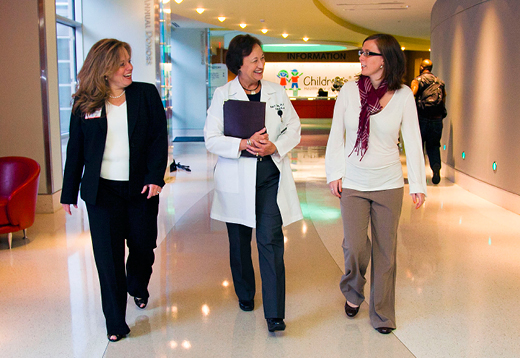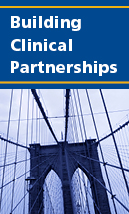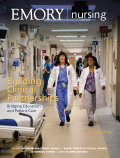Culture of Inquiry

Linda Riley (center) at Children's with nurse Christina Ryan Scott (left) and BSN student Kari Doubleday
|
|
CHILDREN'S HEALTHCARE OF ATLANTA:
Pediatric nurses learn scientific methods to influence care
Nurses who question—even challenge—current practice in clinical care may be nontraditional, but they are the wave of the future, says Linda Riley, director of nursing research and evidence-based practice at Children’s Healthcare of Atlanta.
A budding research collaboration between Children’s nurses and Emory nursing faculty and students promises to strengthen both institutions. More and more, nursing school–hospital partnerships are proving mutually beneficial nationwide.
“Our partnership with the nursing school goes both ways,” says Riley, also an adjunct nursing professor who taught at Vanderbilt University, where she earned a doctorate in nursing science, and at the University of Alabama at Huntsville.
“We benefit from the research expertise at Emory, and they benefit from placement for the 100 nursing students who complete clinical rotations at Children’s every year,” she says. “Nursing students benefit from the diverse population of pediatric patients we see and the complexity of the illnesses we treat.”
Building a “culture of inquiry” among Children’s nursing staff has been one of Riley’s primary goals since starting the nursing research program in 2009.
“I want to empower nurses at the bedside to question current practice,” she says. “This is how research questions evolve from direct patient care. I am hoping to create collaborative teams with our nurses, Emory nursing students, and faculty to encourage this kind of thinking and transfer of knowledge.”
U.S. News & World Report and Parents Magazine both rank Children’s among the top 10 pediatric hospitals nationwide. “To be considered a top-tier health care organization, we must have many layers of excellence, and conducting research is an important component,” says Riley. “Families who bring their children to us trust us to provide the best care possible based on current science.”
Hospital accreditation organizations now expect “evidence-based practice” to be the norm for both doctors and nurses. Evidence-based practice became important for physicians 20 years ago. For nurses, the idea evolved about 10 years ago. “Our nurses must be active consumers of research,” Riley says.
Experienced hospital nurses often must learn new skills for a clinical research program to be productive. That includes writing research proposals, conducting literature searches, staying current on new findings, and conducting research from conceptualizing an idea to publishing study results in nursing journals.
|
"Our nurses must be active consumers of research." —Linda Riley, Children's Healthcare of Atlanta |
||||
Reporting, disseminating, and successfully publishing study results are crucial, Riley says. “If you don’t share what you learn in the larger community, it doesn’t have much value. Academics are very good at all of these things. That’s why this marriage with Emory is the best of both worlds.”
Riley plans to form multidisciplinary research teams of nurses, social workers, physical therapists, and other appropriate professionals. Research proposals with depth and varied expertise are more likely to be awarded funding. Competition is fierce for the shrinking pool of grant funding, making it more imperative for grant applications to show that nurse researchers can use funding effectively.
Riley is building a structure to give Children’s nurses new research tools and skills. “We’ve expanded access to online research journals and databases. We have medical librarians help them find resources. We’ve established nursing journal clubs that may include Emory nursing students and their faculty at our nursing meetings.”
Children’s nursing staff have been very receptive and are hungry to learn more, Riley adds.“We recently held a nursing research symposium in a room that holds 100 people and 150 people registered, so we had a long waiting list.”—Valerie Gregg



